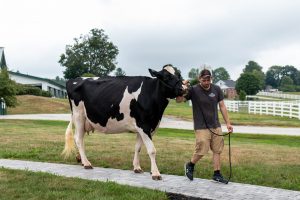DAIRY BARN – CLASSIFICATION
What is Classification?
Classification happens two to three times a year at Pineland Farms. When a classifier from the Holstein Association USA is planning to visit, there is a thirty-day notice given where our farmers work to make the herd look it’s very best. Each cow is assigned a pamper day, including a bath and haircut.
Holstein Association USA was established in 1903 and is the largest dairy breed organization in the world, with over 22 million registered Holsteins in their database. They are dedicated to developing the Holstein breed and are responsible for sending classifiers to farms across the United States, where they evaluate the cow’s physical appearance compared to the breed ideals.
How does Classification work?
Each cow is scored on their appearance compared to the breed ideals. The classifier’s job is to provide an unbiased and thorough breakdown, clearly understanding the animal’s strengths and weaknesses. Each body part receives a score, with the udder scoring the highest at forty points. These scores determine an overall score with the highest possible score of 100. A score of over 90 is an excellent cow. Our highest scoring cow was Pineland Goldwyn Hemi, who scored an excellent score of 96. A committee must evaluate any cow to be classified 95 points or above, and the evaluation can be completely unannounced.
What is a Breed Age Average?
Holstein Association USA also gives the herd an overall score called the BAA (Breed Age Average), which is a way to compare the score of an animal (and herd average) to the average of the breed. Pineland Farms herd has a high BAA, which means that we are achieving our goal of improving the breed generation after generation.
Resources: https://www.holsteinusa.com/programs_services/classification.html


